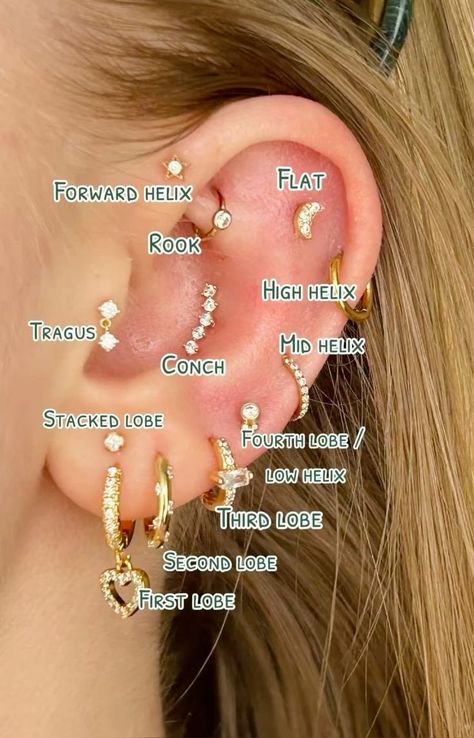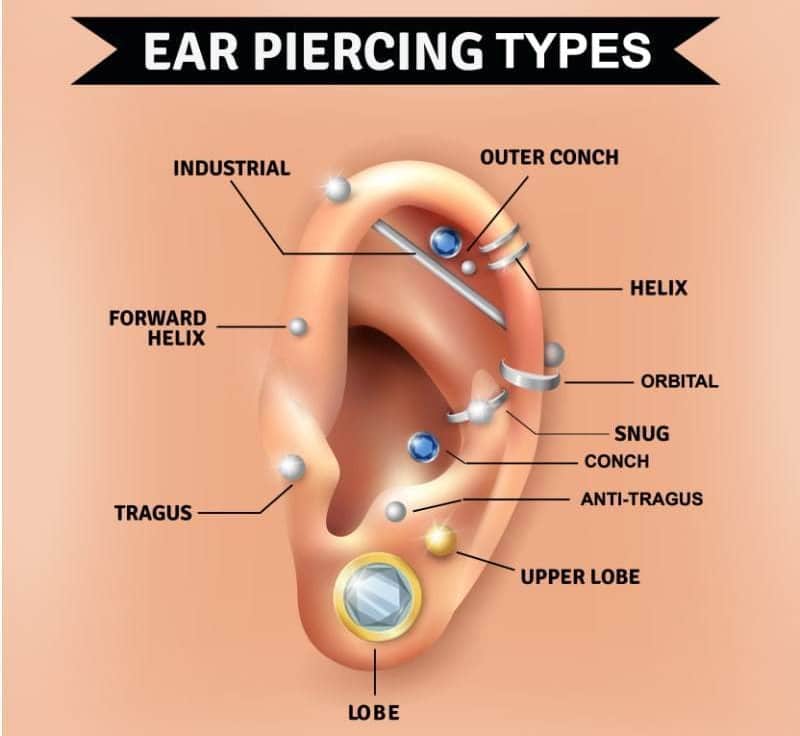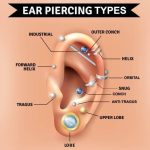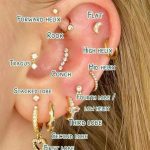Conch Piercing Pain Level Explained: What to Expect & Avoid
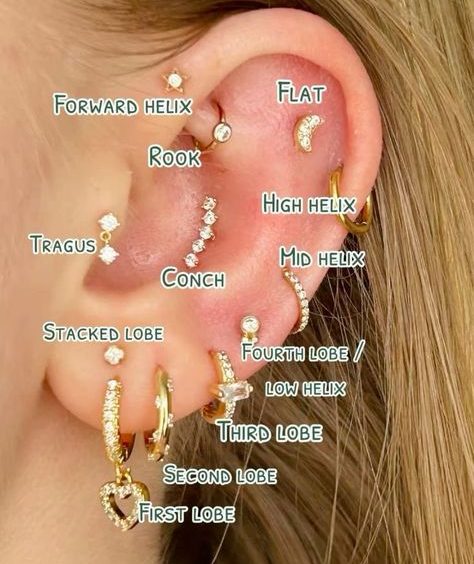
OVERVIEW
Some people claim to have both piercings because they cause similar levels of pain, while others argue that a conch piercing is more painful due to its passage through thicker cartilage. Generally, you can expect conch piercing to be about as painful as other cartilage piercings. A conch piercing is located deeper in your ear; it is somewhat protected, and therefore, the average healing time is between four and six months. However, if you’re sleeping on a piercing or practising improper aftercare, it can take up to a year to fully heal.
In this article, we explain that the pain produced from the conch piercing process, then how much we scale of this hurt, and tell what is conch piercing healing stage and explain that the swelling treatment is from the conch piercing, and tell solutions of this pain that is produced from the piercing method, and tell how to avoid damage process.
Does Conch Piercing Hurt?
A conch piercing in the ear hurts more. It goes through thick ear cartilage. But the initial pain in the ear is brief, with a pinch that subsides relatively quickly. Therefore, the pain levels vary by person. But it is generally considered more painful than an earlobe piercing and may be similar to other cartilage piercing processes. You may feel tenderness and throbbing for many days after the piercing process. Therefore, the pain is produced by the process of conch piercing in the ear.
Initial Pain
. A sharp pinch: You will feel a sharp pinch in the ear when the needle goes through the cartilage.
. Brief duration: The piercing itself is a very fast process.
. Vibrate: After the firstly stage of pinch, you may feel some vibrating throughout the whole.
. Swelling: Some swelling is normal and can be associated with throbbing.
. Emotion: You can expect some soreness, especially when hit or at bedtime, as the area heals so emotion came.
The Scale of Ear Piercing Pain
It is very important to remember that the pain level varies vary person to person, with their body and emotions. So when it comes to conch piercing then the tolerance process of every person depends on their way of thinking. The factors such as your personal pain threshold. So the types of piercing are, firstly, the location on your ear, and secondly, the skill of the piercer can all impact of your comfort. Therefore skill of the piercer is very important for your conch piercing. So the pain of ear piercing is generally considered a more tolerable body piercing in life. The pain process of ear piercing falls between 1 to 6 on average. So, I see how they rank, and let’s dive deeper for each type of ear piercing.
The Ear Lobe Piercings: Simple, Stylish, and Nearly Painless
The Pain level: 2/10
Type of piercing ear lobe piercings is most commonly beginner-friendly friendly which is loved for from simplicity and style. The process of healing time ranges from 6 to 8 weeks with proper aftercare, when we do it from a professional piercer. Because they use a sterilized needle and piercing gun for the ear.
Now, let’s talk about the lobe piercing process, which is the most basic and popular. Many people first-time use for, is on the soft and fleshy part of the ear. The least painful process generally should be considered the process of lobe piercing, due to the amount of soft tissue. The lobe piercing sensation is usually explained as a sharp, brief pinch. Most people find that the pain process is felt and measurable. Otherwise, you feel some pressure and possibly a slight beat sensation afterward. The factness process of lobe piercing process is painless, as there’s no cartilage involved, just soft skin. It is a much excellent procedure for first-timers, that is quick and lasts just last few seconds.
Cartilage Piercings: A Bit Painful but Easy to Solve
Now, the right trending topic is cartilage piercing, especially the hidden helix, which is a style that sits tucked under the ear’s curve. This place gives coolness and a fine look; therefore, people love this place. The process of cartilage piercings is set up in the form of pain. So the cartilage is more rigid than the soft tissue of the lobe. Meaning that the needle process passes through tissue in the harder form in the ear.
Several types of cartilage piercing, like the tragus, conch, and industrial piercing. So small part of the helix is discussed above.
Pain level: 4/10 to 6/10
Helix Piercing
The location of the helix occurs along the top outer edge of the ear. Some other cartilage piercings, though, as not painful. The more pain that can be felt from a brief pinch is more intense than a lobe piercing. From this place, the discomfort quickly fades it but mostly people consider it stings for a moment.
Tragus Piercing
The cartilage that covers the ear canal, but the tragus is the small, thick piece of cartilage. Due to the thickness of the cartilage, piercing through this area can be a bit more painful. Mostly, people explain that it is fast and tolerable, so it can be 5/10 rated often. The process of healing could be a bit longer, but the pain finishes very quickly.
. Conch piercing:
The central part of your ear is the large conch. Conch involves thick cartilage, so the needle has to pass through a large area, and then pain is produced when we do the piercing. It’s typically rated around a 6/10. The pain does not last long, but the initial pinch may be intense.
. Industrial piercing:
The process of industrial piercing involves two holes connected by a bar. One of the more common cartilage pains is known. This process involves piercings through two spots at once, the cartilage, because it is more painful than a single tragus and helix. So, in this result of pain level, which is high and the healing process can take longer. Therefore, the rating is about 6/10.
Rook and Daith Piercings: A Little Painful but Very Trendy
Rook piercing: On the inner side of a piercing, a cartilage is located of a horizontal fold above the daith.
Daith piercing: Near the opening of the ear, a piercing is done on the small inner fold of cartilage.
Those people who love stylish ear designs, then rook and daith become super popular among them. They look cool, unique, and show personality. But they do create a bit more pain compared to simple lobe piercings. Still, it’s completely worth it for the amazing look they give!
So, here are some key points to know before getting one:
Pain level: A sharp pinch, you can feel that finish very quickly. That’s a moderate process.
Healing Time: The healing process, depending on the aftercare around 6 to 9 months.
Placement:
Rock piercing: Inside the ear’s upper ridge.
Daith piercing: In the innermost fold of the ear.
Style options: The best look is of small hoops, heart-shaped rings, or elegant studs.
Aftercare tips: Applying the aftercare process for healing is to clean twice daily with a saline spray and avoid wearing twisted jewelry and sleep more on the opposite side.
It may hurt a little from these piercings, but they’re totally manageable. And their stylish look makes them worth every second!
Factors That Affect Pain Level
When getting a pain, then every person feels this pain differently. This pain can be changed by several simple factors:
Location of the piercing:
Some areas of the body have more nerves and thinner skin. So these areas make a more painful with a sharper feel of a piercing process.
Individual Pain Tolerance:
Every person has a different body process. Therefore, some people have a very strong mind setup system, so they don’t feel pain, but many people have a weak mind setup system, so they feel pain very much. So these people have a stronger mind system, they handle pain very easily other unlike weak thoughts in the mind system.
Piercer’s Skill:
The ability to professionalize his experience works quickly and carefully so which helps to reduce pain and swelling.
Aftercare and Healing:
After the piercing process is completed, the healing process can be easily solved when we do regular cleaning, and then, with this method, prevent the infection.
Conclusion
In this article, we see all the methods of “Conch Piercing pain level explained: what to expect & avoid”. We read firstly that the thoughts of people about conch piercing. Then the secondly, we read that the process of piercing is hurtful or not? Then we saw about the earlobe and cartilage piercing. And then discuss about rook and daith piercings, these are painful, but the handling process is.
All these piercings are done, and in the end, the factors affecting the pain level are observed. By applying the cleaning, sleeping, and jewellery method, the pain level easily managed through these techniques.
FOR MORE INFORMATION: Bloggingshub.com


